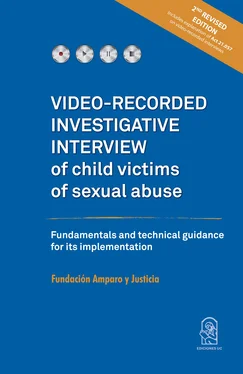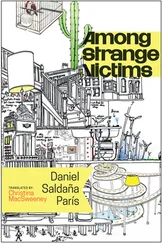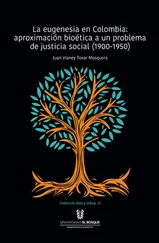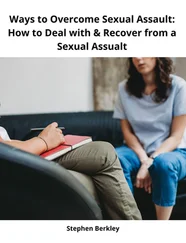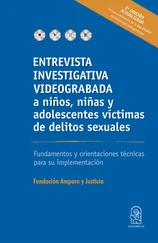Given their age and level of maturity, children are more likely to experience this kind of secondary victimization, especially through the actions of institutions and actors in the justice system7 (Ibero-American Judicial Summit, 2008; UN, 2005 and UN, 1999; Requejo, 2013).
The recognition of this phenomenon and its potential impact on groups of victims in particularly vulnerable conditions has justified the creation of special measures that seek to adapt criminal proceedings so they can fully exercise their rights without being exposed to new negative effects. This facilitates their participation and effective access to justice and reduces the eventual trauma and stress these victims may experience (Burton, Evans and Sanders, 2006; Sanz, 2008).
Various international guidelines describe these measures. Some examples include reducing the processing time of cases; having specialized personnel who might work in coordination with the other institutions involved in the processes in an interdisciplinary approach; adapting the spaces and equipment of courts, police stations and prosecutor’s offices to the needs of the vulnerable group; avoiding direct contact between the victim and the accused; and video recording the victim’s testimony for use in as many instances as possible, to avoid the need for further appearances (Ibero-American Judicial Summit, 2014, 2008; UN, 2005, 1999, 1985).
2. The rights of child victims of crime
The justice system faces a great challenge when addressing the participation of child victims in criminal proceedings: “Every child should be the object of special protection by the organs of the justice system in consideration of their evolving development” (Ibero-American Judicial Summit, 2008, rule No. 5). Investigative procedures and judicial interventions should consider the most unrestricted respect for the guarantees that they have as persons, as children and as victims in a situation of vulnerability8.
Regarding the rights that are intrinsic to their status as children, consideration of their best interests and the right to be heard and taken into account, as affirmed in the Convention on the Rights of the Child (henceforth CRC), are of the utmost importance9 . According to the Committee on the Rights of the Child (2013), they are the general principles that must be taken into account for the interpretation, application and respect of the other guarantees that children have10 . In this sense, it states that all decisions made during judicial interventions must “serve the primary purpose of protecting the child, safeguarding the child’s subsequent development and ensuring the child’s best interests” (Committee on the Rights of the Child, 2013, p. 23).
The concept of the child’s best interests, understood as “the full satisfaction of their rights” (Cillero, 2007, p. 134), is complex, flexible and adaptable11 . In particular situations, its content must be determined on an individual basis, depending on the characteristics and specific circumstances of the child and the particular case. On the other hand, when collective decisions impact a group of children - such as the way in which investigation processes or court hearings will be carried out - the general best interest should be assessed and determined considering the circumstances of the specific group (Committee on the Rights of the Child, 2013).
In the case of child victims of crime, the justice system has the obligation to consider their best interests in all measures or decisions that affect them (UN, 2005; Optional Protocol to the Convention on the Rights of the Child on the Sale of Children, Child Prostitution and Child Pornography, 2000).
Regarding the right of every child to be heard, Article 12 of the CRC states that the child has “ the right to express his or her views freely in all matters affecting the child, the views of the child being given due weight in accordance with the age and maturity of the child .” General Comment No. 5 of 2003 of the Committee on the Rights of the Child, in turn, refers to the right to be heard in item 12 of its introduction, where it “...highlights the role of the child as an active participant in the promotion, protection and monitoring of his or her rights...” . Professor Ton Liefaard adds that, in order to fully exercise this right, particular attention needs to be paid to the provision of information adapted for children (Liefaard, 2019).
In 2005, the United Nations Economic and Social Council suggested guidelines for justice in matters involving child victims and witnesses of crime. Concerning the right to be heard and to express views and concerns, the same council stated that “ professionals should make every effort to enable child victims and witnesses to express their views and concerns related to their involvement in the justice process, particularly: (a) Ensuring that child victims and where appropriate witnesses are consulted on the matters set forth in paragraph 19 above; (b) Ensuring that child victims and witnesses are enabled to express freely and in their own manner their views and concerns regarding their involvement in the justice process, their concerns regarding safety in relation to the accused, the manner in which they prefer to provide testimony and their feelings about the conclusions of the process; (c) Giving due regard to the child’s views and concerns and, if they are unable to accommodate them, explain the reasons to the child .” (p. 8)
There is a complementary link between the right to be heard and the child’s best interests. Indeed, these two principles are interdependent. The proper application of the child’s best interest principle requires respect for the full exercise of his or her right to be heard. In turn, the full exercise of their right to be heard includes the necessary assessment and determination of their best interests. Actors in the criminal justice system should keep both of these rights in mind when interpreting the rules and procedures for the participation of children in justice processes (Committee on the Rights of the Child, 2009; Troncoso and Puyol, 2014).
The Committee on the Rights of the Child (2009 and 2013), in its general comments, states that justice processes should be accessible and appropriate for children, and provides some guidelines in this regard:
All necessary measures need to be taken to guarantee children’s right to be heard, while, at the same time, ensuring their full protection. The potential negative consequences of failing to take their protection into account need to be considered, particularly in cases where the child has been a victim of a criminal offense.
Information and appropriate advice must be provided in a timely manner to children and their parents by the judicial system or other competent authorities.
It is recognized that expressing their opinions is not an obligation. The child may not exercise this right if he or she so wishes.
Children who have been victims of crime should be treated with sensitivity and tact throughout the legal process, considering their special situation, needs, age, gender or any physical impairment.
Judicial interventions should be of preventive nature, whenever possible, and should be part of a coordinated and integrated approach between the different sectors. It is recommended that the different disciplines work together to be able to listen to and properly understand the child, according to their particular needs.
The principle of expediency must be applied in all actions.
With regard to interviews, care should be taken not to intervene more than strictly necessary, especially in cases where events that might cause the child harm are being investigated.
It is preferred that children are not interviewed in public hearings, but rather in private interactions.
Читать дальше
